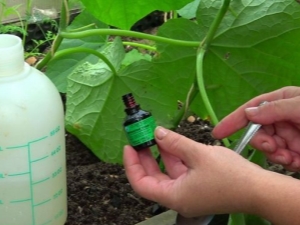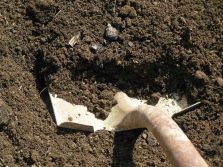Terms of use of brilliant green for cucumbers and tomatoes

Who is unfamiliar with such an antiseptic as brilliant green, which for the purpose of disinfection is always used for abrasions and scratches.Well knowing the functions of this drug, not everyone thinks about what is included in its composition, which allows to provide assistance. It turns out that for the most part brilliant green consists of copper with antiseptic action. This metal in certain quantities has a beneficial effect on any organism, and plants are no exception.
The disadvantage of this trace element, on the contrary, is detrimental, which manifests itself, if we talk about plants, in their unattractive appearance, in easy vulnerability and, as a result, in poor productivity.
Having estimated the composition and useful qualities of the preparation, gardeners have been successfully using green for their homestead lands for more than one decade. The application does not boil down to the banal treatment of the wound of a damaged plant, which is also quite acceptable, but there is a whole system with a formulation for spraying the plants and watering them with a solution based on green paint.
What is the treatment?
In gardens and vegetable gardens it can be used in two ways: as a fertilizer, because it is rich in many minerals, and for its intended purpose, that is, as an antiseptic in the fight against various fungal diseases. The use of green leaf is most often used by experienced gardeners for spraying cucumbers and tomatoes.
Gardeners, caring for quite capricious cucumbers, often make mistakes associated with watering. Due to overflow or underfilling under the influence of adverse weather conditions (drought or constant dampness), the plant is affected by powdery mildew, late blight or any kind of rot, etc. In such cases, applying a spraying of greenhouse-based solution will help to completely and quickly get rid of plant disease.
Especially justified its use in the fight against the rapidly spreading powdery mildew in the garden, affecting other cultures. In addition, the already mentioned solution can significantly improve the condition of the soil in such marshlands as the Leningrad Region, and, thanks to its natural and perfectly safe aniline dye, has a beneficial effect on the appearance of cucumbers.
Tomatoes, as well as cucumbers, due to the interruption in irrigation and adverse climatic conditions, can cause a lot of trouble with the blight that affects them quite often. But, unlike cucumbers, it is advisable not to treat tomatoes with brilliant solution of brilliant green, but to spray them in advance with a preventive purpose.
It is necessary to start prevention when the plant is still considered seedlings. The second time is sprayed at the time of flowering, characterized by relatively weak immunity for the plant. And the last, third time, irrigate a bush on which green fruits have already formed.
It was already mentioned above that the solution on the basis of zelenka is also an excellent, not containing harmful substances, and a nutrient-rich feed for the plant. It is advisable to use the solution as a top dressing at such moments when the plant is stung: at the time of transplanting, flowering, or after harvesting the first crop.
Advantages and disadvantages
The undoubted advantages of treatment and enrichment of both plants and soil with the help of a solution based on green stuff can be considered:
- low cost and availability of the procedure;
- instant disinfecting effect;
- absence of chemical substances harmful to any organism in its composition;
- The substances that make up green stuff contribute to the development of plant immunity;
- feed on the basis of brilliant green helps the plant to quickly recover and gain strength, for example, after the first fruiting.
If we talk about the negative side of the effect of green leaf on plants, then minus one: with improperly maintained proportions and with improper irrigation time or watering, the plant can get burned. And if we allow the root to burn, which is quite probable, then the culture will unconditionally die completely.
To avoid this, it is advisable to use irrigation rather than watering (especially at the stage of familiarization with these procedures). And if the plant needs root feeding, then you should not allow the manufacture of a strong concentrate. There are also favorable and unfavorable days for such procedures. Extremely cautious need to be novice gardeners, because the procedure carried out in adverse days for this, can cause significant harm.
When is it better to spray?
It's no secret that any manipulations with plants should be done either relatively late in the evening or early in the morning. This is the most auspicious time, since there is no sun shattering many plants that can evaporate any irrigation in a few minutes. If we talk about evaporation, then this is one of two factors that can lead to a burn (the second factor is an overdose). The concentrate is water, and the water, evaporating, will leave a brilliant green paint on the plant.
It is equally important that during the irrigation procedure or after it there is no rain, which, washing away the solution, will contribute to its progress towards the root, which in some cases will also cause damage to the root system. Irrigation or root dressing before harvesting should be done at least one week in advance.
Figures for comparison: the treatment of the plant with agrochemicals before harvesting takes 3 weeks. The above fact confirms the harmlessness of the concentrate to humans when ingested. Now the main thing - to learn to maintain the necessary proportions.
How to apply?
For prophylaxis and for treatment, their own recipes for the preparation of a concentrate have been developed, based not only on different dosages, but also on different components. For prevention, the solution should not be as strong as for treatment. For preventive purposes, aimed at cucumbers, it will be enough to dissolve one drop of brilliant green per 1 liter of water. We spray in the "heavy" periods for the plant described above. It is important that the concentrate gets on the leaves on both sides and across the bed.
When detecting the first signs of disease on the basis of rot, the amount of green stuff in the solution is increased to about 2-3 drops per liter of water. Irrigation with such a composition should be at least 2 times a week after an equal number of days.
If powdery mildew is diagnosed on the beds, it is recommended to replace the water with whey, for which 3 liters of green water is taken 3 liters. For a quicker effect, you can still finish 10 grams of urea. It is more difficult to fight this disease, so the treatment is carried out every 4 days until the signs of the disease disappear. In the absence of natural whey, the concentrate for the control of powdery mildew can also be prepared on water, using 10 milliliters of Zelenka and iodine per 9 liters of water.
Tomato is a less delicate culture than cucumbers, so for preventive measures aimed at the emergence of phytophthora, you can use about forty drops of brilliant green for a full ten-liter bucket of water.
Phytophthora affecting tomatoes is rather stable, easily withstanding high winter temperatures (especially in greenhouses and greenhouses). In order not to collide with it in the new productive year, it is necessary to make a mandatory soil disinfection until the fall. To do this, after harvesting and removal of dry shrubs, it would be good to produce a concentrate, prepared at the rate of 50 milliliters of brilliant green, on a bucket of water. Watering for disinfection can only be the soil on which there are no plants. Otherwise, a strong solution will destroy the root system of the growing culture. This is all that concerns the treatment, and after all, brilliant green is also used as a top dressing in which it is combined with iodine.
Feed the plant with copper contained in the required quantity in Zelenka, preferably through the root system.The procedure will be particularly relevant in the marshland, scarce on the said element, which makes the culture stronger and more enduring. Experienced growers always combine brilliant green with iodine, which is taken in smaller quantities. Zelenka and iodine, complementing each other, make plants more protected from diseases, improve their yield and appearance, since such a solution is rich in not only the already noted copper, but also potassium with phosphorus.
To enrich the plant with beneficial substances, 10 drops of iodine and 20 drops of green stuff are taken for 10 liters of water. Since the plant receives nutrients through the root, then we do top dressing not through irrigation, but through basal watering. Feeding up a young plant with not yet formed pomp of the bush, it is better to use a watering can, irrigating almost from all sides.
And for an adult plant, either a watering can without a sprayer or a bucket is more suitable, which will allow the jet to be directed directly to the root. After watering the wet ground, it is necessary to dry the dry ground, as the probability of evaporation of the introduced useful substances is allowed.
Should not forget that a surplus of beneficial substances is also dangerous for the plant, as well as their lack. In this regard, basal feeding, described above, should be carried out when the need arises. Attentive gardeners determine the deficiency of microelements by the changing appearance of their culture, in particular, by the changing color of the leaves or their twisting. These manifestations need to be especially careful if the soil on the site can not be called fertile, and the autumn-spring dressing was not carried out. Or, on the contrary, having spent a seasonal top dressing of the soil, it is not necessary to take a great interest in frequent enrichment of a plant by microelements of a solution of zelenka and iodine. It is necessary to understand that a plant needs a certain period of a microelement.
Phosphorus, for example, is irreplaceable in the formation of the root system, its deficiency is manifested in the twisting of the sheet up. Potassium is responsible for resistance to pests and rapid temperature changes. Its shortage is manifested in small sheets uncharacteristic of the plant, curled downwards. Over time, the twisted edges begin to dry and crumble. Excess potassium causes the leaf plate to stain a brown color.
Given the above principles with the state of the soil and the climatic conditions of a particular region, measures aimed at improving the yield, you need to take in advance and carry them out not randomly, but according to a planned system. It is worth noting that a special approach is required by the soil in the greenhouse or in the greenhouse and the plants grown in them. This is due to the large accumulation of moisture in devices for protected ground. Since moisture with insufficient ventilation contributes to the appearance of rot, an aqueous solution based on brilliant green will be very useful.
Since it is easier to prevent any disease than to fight it, in such places it will be useful to carry out preventive and autumn soil disinfection and spraying during transplanting, during flowering and at an early stage of yield.
How to use brilliant green in the garden, see the following video.

































